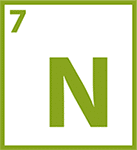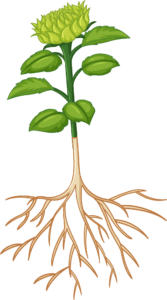Symbol: N
Availability: available to plants as nitrate (NO3–) and ammonium (NH4+) ions.
Nitrogen functions

It is a necessary component of proteins, several vitamins, nucleic acids (DNA and RNA), phytohormones and secondary metabolites.


It imparts dark-green color in plants, promotes leaves, stem and other vegetative part’s growth and development. Moreover, it also stimulates root growth.

It is a major part of the chlorophyll molecule and is therefore necessary for photosynthesis.

It produces rapid early growth, enhances the growth of leafy vegetables, increases protein content of fodder crops.
After carbon, nitrogen (N) is the element required in largest amount by plants. About 1–5% of total plant dry matter consists of N, which is an integral constituent of many plant structures and for both their internal and external metabolic processes. For this reason and due to its high mobility in soil, N is also the nutrient that is more deficient for most crops all over the world.
The availability of N to roots is a decisive factor for plant growth. Nitrogen forms approximately 78% in the earth’s atmosphere, but atmospheric N2 is only available to plants that can form symbiosis with N2-fixing soil bacteria. Since plants cannot use or take nitrogen directly from the atmosphere, they depend on other N compounds for their growth.
This element can be absorbed by roots in three forms as organic N, ammonium (NH4+) or nitrate (NO3–). The major sources of N taken up by the roots of higher plants are nitrate and ammonium. The nitrate is the main source of N for most crop species; however, this depends on the plant species and other factor like the pH and the temperature of the soil. Ammonium absorption is favored by the high pH, whereas nitrate is favored by low pH.
The nitrate uptake by plants is reduced to form ammonia and N is combined in organic vegetal chains, forming glutamic acid and other amino acids. Consequently, plants have evolved mechanisms to modulate their N acquisition efficiency in response to availability and form of external N as well as to plan N demand during their life cycle. This includes having several N transport systems which mediate uptake at different external concentrations as well as being able to change root system architecture to allow better exploration of a particular soil volume or further exploration of a larger volume.
The availability of N sources in the soil varies substantially in time and space, depending on soil properties
such as texture, pH, moisture, and microbial activity.
Nitrogen is an essential nutrient which plays an important role in many vital functions and compounds necessary for plant growth and development. Nitrogen is a constituent of protein, build from amino acids that involves in catalyzation of chemical responses and transportation of electrons. It is also a basic component of chlorophyll which enables the process of photosynthesis. Nitrogen plays a most important role in various physiological processes. It imparts dark-green color in plants, promotes leaves, stem and other vegetative part’s growth and development. Moreover, it also stimulates root growth. Nitrogen produces rapid early growth, improves fruit quality, enhances the growth of leafy vegetables, increases protein content of fodder crops; It encourages the uptake and utilization of other nutrients including potassium, phosphorous and it monitors overall growth of plant.
Nitrogen is also a component of nucleic acids (DNA and RNA) that form the genetic material involved in the transfer of crop traits and gene expression. It is also a component of phytohormones and secondary metabolites.
Plants containing such an amount of N which limits its growth deficiency symptoms show general yellowing
(Chlorosis) of leaves, appearances of red and purple spots on the leaves and reduced growth. To achieve efficient growth, development and reproduction, plants require adequate, but not excessive, amounts of N. Therefore, low soil N availability or a decline in root uptake capacity will negatively affect plant productivity and ecological competitiveness. Nitrogen deficient plants are typically stunted, with narrow leaves.
Chlorosis caused by N deficiency typically begins in the older leaves as N is remobilized to younger leaves. At the field scale, N-deficient crops appear pale green or even yellow. The canopy height is lower and, in grasses, tillering as well as the number of seeds per inflorescence are reduced compared to plants growing with adequate N. The potential photosynthetic capacity of the plant is limited, ultimately inhibiting whole plant growth.
An adequate supply of nitrogen is critical for supporting plant growth, but this nutrient is vulnerable to leaching through soil. In fact, soils cannot retain nitrates for later uptake. In crops, and particularly in cereals, large amounts of N fertilizer are required to reach maximum yield and NUE is estimated to be less than 50%, which means that less than 50% of the applied N fertilizer is utilized by the crop. The N which is lost from the plant-soil system can result in environmental problems, including water and air pollution. In addition, incomplete capture and poor conversion of fertilizer-derived N causes global warming through emissions of nitrous oxide. The extent of leaching depends mainly on soil properties and timing of nitrogen application. Minimizing nitrate leaching from the root zone requires a careful management of nitrogen fertilization able to improve Nitrogen Use efficiency. Nitrogen use efficiency can have several meanings in the context of crop production. In general, NUE is the ratio between the total biomass of output and the N input. NUE is divided into two components: N uptake efficiency (NupE; the ability of the plant to remove N from the soil) and the utilization efficiency (NutE; the ability to use N to produce biomass or yield).
A proper nitrogen fertilization management increases soil fertility, achieves cropping system goals of increased production, increases farmer profitability, and improves sustainability. This is possible choosing the right source of nitrogen, the right rate which ensure an adequate supply to meet plant demand, the right time considering the crop needs through the growth cycle and finally the right place considering root-soil dynamics and nutrient movement, also managing spatial variability.
The urgent need to reduce the use of synthetic fertilizers while increasing the NUE and maximizing crop productivity is a great challenge for modern agriculture. Furthermore, the increase of commodities prices, which is occurring globally, opens up the need to implement agronomic strategies to reduce the application dose of fertilizers safeguarding, at the same time, crop productivity and the profitability of farmers. Plant biostimulants represent a promising strategy to boost sustainable agricultural production thanks to their capacity of improving directly or indirectly nutrient use efficiency of crops especially under low nutrient availability.
Nitrogen is an essential nutrient which plays an important role in many vital functions and compounds necessary for plant growth and development.







